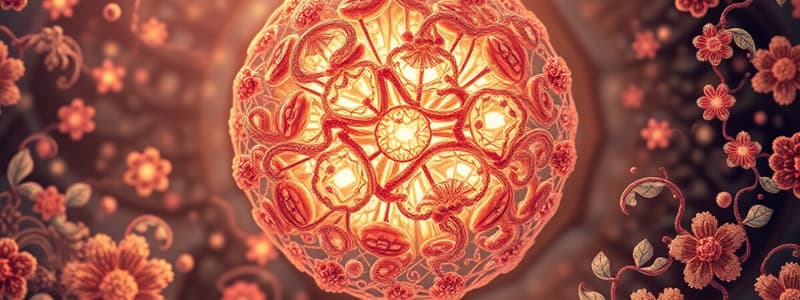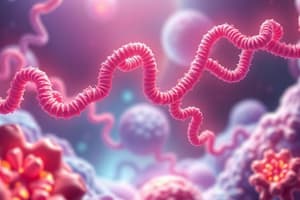Podcast
Questions and Answers
What is the role of RNA polymerase in transcription?
What is the role of RNA polymerase in transcription?
- RNA polymerase forms covalent bonds between sugars and phosphates on the mRNA strand.
- RNA polymerase guides transcription by reading the DNA code and assembling the mRNA molecule. (correct)
- RNA polymerase breaks the hydrogen bonds between DNA base pairs.
- RNA polymerase attaches free-floating RNA nucleotides to DNA bases.
Which of the following statements accurately describes the difference between DNA and RNA?
Which of the following statements accurately describes the difference between DNA and RNA?
- DNA uses thymine (T) as a base, while RNA uses uracil (U) as a base. (correct)
- DNA is found in the cytoplasm, while RNA is found in the nucleus.
- DNA contains the sugar deoxyribose, while RNA contains the sugar ribose.
- DNA is single-stranded, while RNA is double-stranded.
What is the function of the start codon (AUG) in translation?
What is the function of the start codon (AUG) in translation?
- The start codon determines the sequence of amino acids in the polypeptide chain.
- The start codon binds to the tRNA molecule, bringing the first amino acid to the ribosome.
- The start codon codes for the amino acid methionine and initiates the process of translation. (correct)
- The start codon signals the end of translation and the release of the polypeptide chain.
During translation, what is the role of tRNA?
During translation, what is the role of tRNA?
Where does transcription take place?
Where does transcription take place?
What is the name of the bond that forms between amino acids during the translation process?
What is the name of the bond that forms between amino acids during the translation process?
What is the name of the sequence of three nucleotides on tRNA that binds to the complementary codon on mRNA?
What is the name of the sequence of three nucleotides on tRNA that binds to the complementary codon on mRNA?
How many mRNA nucleotides are required to code for one amino acid?
How many mRNA nucleotides are required to code for one amino acid?
Flashcards
Protein Synthesis
Protein Synthesis
The two-part process involving transcription and translation to create proteins.
Transcription
Transcription
The process of making mRNA from a DNA template in the nucleus.
Translation
Translation
Using mRNA to assemble proteins at ribosomes based on genetic code.
Codon
Codon
Signup and view all the flashcards
Anticodon
Anticodon
Signup and view all the flashcards
Start Codon
Start Codon
Signup and view all the flashcards
Stop Codons
Stop Codons
Signup and view all the flashcards
RNA Polymerase
RNA Polymerase
Signup and view all the flashcards
Study Notes
Protein Synthesis Overview
- Protein synthesis is a two-part process: transcription and translation.
- The process ultimately produces proteins from DNA instructions.
Transcription
- Location: Occurs in the nucleus of a cell.
- Purpose: Creating mRNA from DNA.
- Steps:
- DNA "unzips"
- RNA polymerase breaks hydrogen bonds between base pairs.
- Free-floating RNA nucleotides attach to DNA bases on one side of the DNA molecule.
- Covalent bonds form between sugars and phosphates on the mRNA strand.
- mRNA is released and DNA "zips" back up.
- RNA polymerases (enzymes) guide transcription by reading the DNA code.
- mRNA: Messenger RNA carries information from DNA to ribosomes.
Translation
- Location: Occurs at ribosomes in the cytoplasm of a cell.
- Purpose: Using mRNA to make proteins.
- Steps:
- mRNA leaves the nucleus and travels to the ribosome.
- Amino acids are brought to the ribosome by tRNA.
- tRNA bases (anticodons) pair with mRNA bases (codons).
- Amino acids join together by peptide bonds to form a protein (polypeptide).
RNA vs DNA
- DNA:
- Contains thymine
- Double-stranded
- Deoxyribose sugar
- Stays in the nucleus
- Only one type
- RNA:
- Uracil replaces thymine
- Single-stranded
- Ribose sugar
- Travels between nucleus and cytoplasm
- Three types: mRNA, tRNA, rRNA
Importance of RNA
- mRNA takes the code out to the ribosomes
- tRNA brings amino acids to the ribosomes to make proteins.
- Information is transferred from DNA to RNA to proteins. This is known as the central dogma of molecular biology
Terms related to translation
- Proteins are made from amino acids
- The order of bases determines which amino acids are used
- 3 mRNA nucleotides = codon
- 3 tRNA nucleotides = anticodon
- 3 bases = 1 amino acid
Additional Translation Details
- Anticodons are specific to tRNA; each tRNA only brings a specific amino acid to the ribosome.
- Start codon (AUG) begins translation
- Stop codons (UAA, UAG, UGA) end translation
Diagram of Protein Synthesis
- A visual representation of the process is crucial for understanding.
Base Pairing
- A-U, U-A, G-C, C-G important for correctly matching components during protein synthesis.
Studying That Suits You
Use AI to generate personalized quizzes and flashcards to suit your learning preferences.




